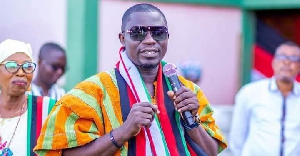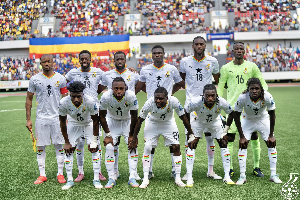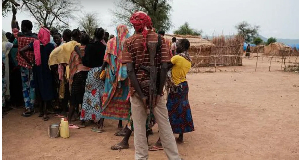A universally acknowledged truth is that there must be something inexplicably wrong with Africa. How can a continent endowed with so much natural wealth be so poor? How can a green desert be possible? Whatever bad leadership, colonial vestiges, social fractures or other negative forces are at work in Africa must be worse than everywhere else to make this paradox make sense, say many a political economist, development historian and cultural theorist.
Because mineral endowments are the most measurable of all forms of natural wealth, the above framing of Africa’s mindboggling predicament is often facilitated by the listing of percentages of a particular mineral commodity produced or found in large reserves in Africa.
In this respect, commentators from both Africa and elsewhere converge. Moses Olade, an eminent Professor of Geology formerly with the University of Ibadan in Nigeria, for instance, says that in 2019 Africa produced 92% of the world’s platinum, 89% of its gold, 71% of its cobalt, 75% of its diamonds, 60% of its chromium and 49% of its manganese.
Given that Africa’s share of global population is only 17%, these numbers can only convey one message: Africa is the world’s most naturally endowed continent Similarly, the United Nations Environment Programme asserts that:
Africa is home to some 30 percent of the world’s mineral reserves, eight per cent of the world’s natural gas and 12 per cent of the world’s oil reserves. The continent has 40 percent of the world’s gold and up to 90 percent of its chromium and platinum. The largest reserves of cobalt, diamonds, platinum and uranium in the world are in Africa. It holds 65 per cent of the world’s arable land and ten percent of the planet’s internal renewable fresh water source. In most African countries, natural capital accounts for between 30 percent and 50 percent of total wealth.
The respected Mo Ibrahim Foundation concurs.
Each restatement of the message redounds on the foundational puzzle: how can a continent so rich be so poor?
The ‘green desert’ is a mirage
Like many grand truths, the ‘Africa impoverished in the midst of plenty’ trope does not tell the full story. More than that, its simplistic rendering of a more complex reality has created a massive strategic blindspot – or mirage – preventing many African leaders, policy-makers and thinkers from reflecting on new and innovative ways about how to manage their country’s mineral endowment.
The flawed paradox of plenty narrative promotes a thesis that Africa merely has to safeguard what it has through more aggressive resource nationalism. In this essay, we hope to overthrow this narrative and sound an alarm for an urgent, almost desperate, need to pursue an elaborate, technology-driven and innovation-focused mineral wealth management model – one that does not assume global dominance (or even prominence) as vital for African agency, or accept that resource nationalism alone would be enough to ensure that Africans benefit from mines in their communities and minerals dug from their backyards.
Beyond the alarm, this essay describes one such model, currently under conceptualisation. Apart from the relevance of such an exercise to Africa’s economic emancipation in a time of permanent global polycrises, such a strategic reframing is also critically needed in the context of heightened geopolitical competition over mineral resources, with Africa seen as an emerging theatre for conflict among the great powers.
The hard numbers of Africa’s mineral wealth
The first thing to set right from the outset is the notion that Africa has some sort of global dominance in mineral terms. Taking a more comprehensive view (instead of the cherry-picking of specific minerals with no regard to those minerals’ overall strategic importance), Africa’s mineral wealth is actually quite ordinary, and in some important respects not a good indicator of Africa’s global standing in this area.
For example, instead of Africa’s share of global gold production being 89% as Professor Olade asserts, the continent’s actual share is a much more modest 9%. Ghana, the only African country on the list of top 10 global gold producers, has an output less than 40% that of China, a country rarely associated with the mineral but which is in fact the top global producer.
Likewise, Africa’s share of global diamond production volume is about 46%, not the 75% Professor Olade claims (NB: Africa’s importance started to drop in the mid-twentieth century). Rather than the 60% of chromium production he attributes to Africa, the correct answer is about 45%. Such wrong statistics are endemic in the commentary on Africa’s resources.
There is no doubt that, judging by its roughly 18.5% of world population, Africa’s control of half of global manganese production, 70% of its cobalt output and 82% of platinum mining is impressive. But such selective statistics do not help paint a fuller picture when Africa’s share of global industrial minerals output as a whole is just 5.5%. Or when Australia’s annual export earnings from exceed that of the entire sub-Saharan African continent’s equivalent income. Consider the implication of that last fact. The average mineral income of the average Australian is, at about $15,000 a year, as much as 60 times higher than that of the average African, at about $250 a year.
Cherry-picking also obscures a vital issue: the minerals that abound in Africa tend to be less valuable than those it lacks. The value of iron ore produced in the world every year is more than $250 billion. The figure is similar for copper. Contrast this with the roughly $8 billion per annum earned by the DRC, despite supplying 70% of the world’s cobalt. Or with the $5 billion Africa earns from supplying approximately 70% of the world’s manganese.
The reader might assume that the picture changes when the emphasis shifts to “reserves”, rather than production. Unfortunately, it does not. Take vital industrial minerals, for instance. Africa has less than 4% of the world’s lithium reserves, less than 5% of its copper, less than 1% of its iron, and less than 1% of its nickel. Nor is all this down to an unfair distribution of exploration activities or resources; Africa receives significantly more exploration dollars relative to its population and minerals reserve share than Asia and many other regions of the world.
Confusions of Professor Olade’s kind can be harmful to strategic analysis, such as when, in a discussion about Africa’s critical minerals positioning, the Mo Ibrahim Foundation begins with the claim that Africa ‘holds 30% of the world's minerals’ that are critical to a low-carbon future.
Whilst the precise basket of critical minerals can be hard to determine, using the usual lists preferred by the likes of the OECD (which encompasses the 17 rare earth minerals plus others like lithium, cobalt, nickel and copper vital to the green transition) as the base, and then computing Africa’s share of reserves of minerals on that list, yields an overall share less than 4%.
In fuel minerals (such as petroleum), Africa’s share of global supply has dropped from 12.5% in 2010 to 7.5% in 2022, a development totally at odds with the picture global analysts like IHS have been painting for many years now. In 2006, HIS projected that Africa would account for 30% of global growth in hydrocarbon production from 2010. It has not adjusted these rosy forecasts since.
Where Africa is strong in respect of certain minerals, reserves and production are concentrated in only a few countries. South Africa produces 95% of the continent’s platinum and the DRC produces a bigger percentage than that of its cobalt, for instance, putting into better perspective DRC’s global significant 50% share of world cobalt reserves Why this paradox matters
Why is it a problem if important commentators with an outsized influence on strategy misunderstand Africa’s true minerals ownership?
First, it blinds the continent to the precarity of its situation. If Africa’s reserves and production output are abundant, then getting its strategy right is less urgent and its margin for strategic error is wider. If the opposite is true, as I argue, then the exigency is direr and the need to pay attention to emerging risks which could be compounding is deeper and more pressing.
Second, it puts certain things into perspective about the limits of simple ‘good leadership’. Whilst good leadership would no doubt help Africa make the most of its minerals, recognising the continent’s relative mineral poverty underscores the critical importance of sound strategy, especially when ‘good leadership’ is often limited to such virtues as low corruption and tough bargaining during mineral lease negotiations. In the kind of strategic tightrope situation described in this essay, such virtues can only go so far.
Third, it highlights a historical disadvantage that is almost universally unknown. When Europe was ascending the curve of its industrialisation trajectory, it dominated in the critical industrial minerals of that era, such as coal and iron. From 1875 to 1910, Europe’s share of iron production was consistently above 50%, and at times exceeded 70%.
Between 1850 and 1900, Europe’s share of production of all important industrial minerals and metals stayed above 40%, peaked above 60% in 1870, and was above 50% for the most crucial 30 years of its industrial expansion phase. In a major recent review of data by Cambridge University researchers as part of a project called Economies Past, ample evidence was unearthed showing that a mining boom in Europe almost perfectly coincided with the peak of European industrialisation.
This essay argues that Africa’s situation is almost exactly the opposite of Europe’s when the latter was ramping up its industrialisation: the continent is attempting to industrialise at a time when it is relatively poor in economically important minerals. The continent then, clearly, cannot rely on a natural resource dominance-assertion paradigm for its global industrial strategy, contrary to what many commentators say.
Vertical value-addition strategies for industrialisation that pair import-substitution with resource nationalism as the principal means of helping Africa break into major global value chains will remain on paper since the continent does not have the heft many think it does. How the circular economy is changing ‘mineral abundance’
Regarding this essay’s first and most crucial point about avoiding the strategic blindspot covering the continent’s precarity, the least understood and fastest intensifying risk is in the area of recycling and the broader circular economy concept. So much so that the Mo Ibrahim report referred to earlier did not even give it cursory attention.
Yet, recycling rates for industrial minerals in some of the world’s biggest markets, such as the European Union, are going through the roof. As much as 90% of all steel products and 75% of aluminium are recycled, with significant implications for iron and aluminium ore imports.
Between 2018 and 2022, recycling rates for feldspar jumped from 50% to 72%, for talc it moved from 58% to 65%, from 52% to 58% for kaolin and from 63% to 67% for lime. As far back as 2017, industry associations were reporting cobalt recovery and recycling rates in the EU at 68%. Platinum, another of Africa’s prize minerals, has a 95% potential recycling rate and an actual rate of up to 60% from catalytic converters.
The EU’s statistics body says that, as at 2021, 48% of all batteries and accumulators sold in the EU were from recycled and recovered stock. More instructive is the fact that the EU has set much higher floors by 2030 for recycling rates for cobalt, nickel and copper of 90%, and 35% for lithium. China has similar targets.
The more minerals are recovered from waste in the giant consuming markets of Europe, the US and China, the less room for growth African mines will see even for those minerals where Africa does enjoy strategic importance. Considering the higher ESG risks often associated with African mining, growing recycling capacity in markets considered safer from a regulatory standpoint has already led some potential investors to switch strategy from primary mining in Africa to waste recovery/recycling (‘urban mining’) in the Global North.
For example, in a recent agreement between ERG and Electra, the parties clearly expect onshore recycling in North America to steadily offset the need for primary mining in DRC over time. The agreement followed regulatory challenges for ERG in the DRC in the months prior. Meanwhile, Apple, the American electronics giant, has committed to source only recycled cobalt in less than two years’ time. In short, whilst circularity is great for the world, it could be damaging for Africa’s few globally important mineral-producing countries.
Whilst it is common among certain analysts to downplay the impact of recycling on the demand-supply dynamics of green minerals in the short to medium term, many such analyses overfocus on the issue of already mined stock. A standard formulation of the limit imposed by ‘available stock’ is this assessment by a group of French-Canadian analysts: ‘However, secondary mineral production is limited by the total amount of mineral that has already been mined, so that recycling in itself cannot sustain a growing demand’.
Constraining the growth curve of secondary production through circular mining seriously underestimates the role and prospects of logistic efficiencies available in circular scenarios, but not in primary mining. Unlike the case of ‘money velocity’ shifts triggered by fintech innovations like central bank digital currencies (CBDCs), logistic velocity surges as a result of higher circularity of green minerals should be a very intuitive concept.
Improving the rate at which electronic waste is aggregated, delivered to recycling sites, turned around into usable materials, incorporated into just-in-time delivery manufacturing and then turned into consumer gadgets should have clear and sustained effects on how far any quantity of material feedstock can be stretched to cover consumption needs, and therefore aggregate demand.
There are substantial differences between the supply environment of circularly mined minerals/materials and that of primary minerals. Many of the geopolitical, speculative, cross-border customs, trade cycle gaming and similar factors that turn market volatility into constraints on commodity supply do not necessarily apply to the secondary mining of minerals close to high consumption markets with advanced just-in-time reverse logistics infrastructure.
Consequently, producers could coordinate with recyclers to smooth and assure supply and speed up the delivery loops and cycles of recycled industrial minerals in some pretty fantastic ways. Such logistic chains will also be more amenable to the power of digital optimisation than is the case for today’s incumbent linear commodity chains.
It bears emphasising that recycling is not the only trend associated with eco-circularity in the minerals and materials space. Another fascinating development is the synthesis of materials, usually sourced through mining, in the lab as a way of reducing their adverse environmental and social footprint (including through CO2 capture).
Diamonds come to mind. Between 2022 and 2023, laboratory output of synthesised diamonds grew by more than 16%. In a few years, diamond-dependent economies in Africa like Botswana (90% of exports) and Sierra Leone (65% of exports) could find themselves under serious balance of payments stress as the jewellery industry shifts to lab-formulated alternatives marketed as more ethical and more eco-friendly.
A situation that will compound the woes in the diamond sector: production plummeted by more than 30% between 2004 and 2021. Mirroring this trend, the contribution of diamonds to Sierra Leone’s GDP, at constant prices (i.e. after adjusting for inflation), fell by 30% between 2019 and 2023 (from 296 million leones to 207 million leones). This is even before complementary trends like the recycling of diamond tools have caught on. With work ongoing to introduce similar ‘synthetic discontinuities’ in the supply of other minerals, including some very rare ones, this is certainly a trend worth keeping an eye on.
The diamond case study also highlights one easily misunderstood fact: circular impacts will be material-specific and spatially bound in the mid-term horizon. Thus, they need not affect the global supply and demand landscape as a whole to have disproportionate impacts on specific African countries. For example, while ongoing efforts by Chinese chemists to synthesise diamonds indistinguishable from natural gemstones will at some point extinguish large supplies from Botswana and Sierra Leone, Russian mega-producers are themselves exploring ways and means to mix natural and synthetic diamonds to forestall market share erosion.
Another factor deepening the precarity of Africa’s mineral capacity is the steady improvement in AI prospecting, which offers investors the power to mine African cadastral data, not to expand and enhance exploration on the continent, but to sharpen search parameters for minerals in jurisdictions perceived as less risky or with lower ESG constraints.
The combined effect of all these unfolding dynamics is the strategic marginalisation of Africa’s mining power, and the urgent need for African economic actors, both in business and policy, to respond more innovatively.
Africa’s strategists need to be more aggressive in transitioning from basic primary mining into a more sophisticated, digitally enhanced, circular-compatible and ESG-manageable materials industry. This is not the usual ‘value addition’ nice-to-have situation; it is a do or die affair. Introducing Chain Royale
This author recently secured a Bellagio residency, courtesy of the Rockefeller Foundation, to explore just such a strategy, one that he and his collaborators have termed ‘Chain Royale’. Chain Royale at its base is an extension of the better-known concept of traceability: the tracking of a physical good from production to consumption to manage risk. It extends that concept from its current linear form into a circular model whereby traceability continues through each recycling loop of the tracked material, be it cobalt in batteries, silica in solar panels or platinum in catalytic converters.
Such ‘circular traceability’ will be valuable for the world as a whole for various reasons, but for Africa in particular it is critically urgent. First, unethical recycling is already happening, and will worsen. E-waste is dumped all over the world in places with poor regulatory capacity so that the cheapest and dirtiest methods can be used to extract precious minerals at the lowest cost, after which the rest of the waste is consigned to landfills or simply incinerated in carcinogen-filled open-air furnaces.
Aside from the environmental issues, some recyclers have an ask-no-questions policy. Others provide cover to all kinds of organised criminal activities. Shady recycling obscures the real source of the primary minerals purported to have been recycled and can easily become a false source of minerals, undermining programmes like the Kimberly Process.
Just as innovator-activists, like this author, have over the years built traceability technologies and multistakeholder alliances to fight counterfeit medicines, seeds, cosmetics and other life-impacting products due to the presence of criminal cartels in these supply chains, circular-traceability is increasingly important in preventing shady recyclers from providing cover for minerals smuggled from conflict zones or mined with child labour, among other infractions. Else, the reputational risks for Africa-sourced minerals will be compounded by the collapse of audit trails, worsening the continent’s already precarious position.
Second, with growing pressure on volumes will come the need to more effectively tackle smuggling, misdeclaration, round-tripping and a host of supply chain problems that do not manifest in a linear form. The complex multi-loop supply chains that have emerged as a result of the ever-complexifying nature of global mineral trading are best secured and fortified with circular-traceability techniques.
The third and last principal basis for promoting circular-traceability protocols may sound outlandish at first but, carefully studied, it is revealed to be impressively practical. Today, the reverse logistics systems that enable the effective collection, consolidation and distribution of the electronic waste from which minerals can be extracted or recovered do not really connect with consumer lifestyle networks in any way.
The incentives for gathering, aggregating and processing waste to obtain secondary minerals are furthermore not linked in any way to the original communities in which the primary source of those minerals is located. A lot of potential value is clearly being lost due to that lack of connection. Consumers are not plugged into the effort, losing brands embracing circular sourcing massive goodwill, and the rest of the supply chain a powerful organising force for the last-mile of the reverse logistics system.
Digital technologies can connect all these key actors, generate value from their actions at various steps in the chain and – this is crucial – share that value with communities where primary materials are sourced.
This ‘circular royalties’ paradigm is already very well established in the intangibles space, such as music, NFTs (at least during its brief, glorious run), and, in an oblique sort of way, various forms of complex commodity derivative contracts.
There is no reason why, with ingenuity, commitment by the principal stakeholders in the value chain and some legal wizardry, such a model cannot be used to generate resources for Africa: resources that can be channelled through community trusts in Africa to finance green-transitional opportunities which, in turn, will over time redress existing marginalisation in mining communities that have never been served very well by the mining industry.
A clarion call for rethinking Africa’s ‘mineral wealth’ strategy
The clarion call of this essay is straightforward: Africa is not as rich in mineral resources as many people think. The task therefore of optimising and maximising what it has is thus bigger, harder and much more urgent than is usually supposed.
New economic models like circularity and fast advancing recycling technologies and growing investments in capacity are shortening the time horizon for Africa’s beleaguered mining communities to benefit from the mineral resources that they do have. Bringing these strands of analysis together points in only one direction: the use of clever innovations to extract value across the full, increasingly circular and/or multiloop value chains of minerals and other primary materials.
Such a push, however, will require massive coordination across policy, politics, economics, business and global cooperation. This is the kind of ‘new multilateral’ transmediation opportunity dressed as a problem needing oversolving that the world, in particular African developmental strategists, must learn to recognise and heartily embrace.
Opinions of Friday, 17 May 2024
Columnist: Bright Simons















